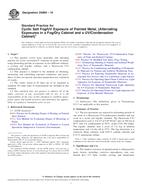Potřebujeme váš souhlas k využití jednotlivých dat, aby se vám mimo jiné mohly ukazovat informace týkající se vašich zájmů. Souhlas udělíte kliknutím na tlačítko „OK“.
ASTM E2338-11
Standard Practice for Characterization of Coatings Using Conformable Eddy-Current Sensors without Coating Reference Standards
Automaticky přeložený název:
Standardní praxe pro charakterizaci Coatings Použití přizpůsobivé Eddy-proudové senzory bez povlaku referenčních standardů
NORMA vydána dne 15.2.2011
Informace o normě:
Označení normy: ASTM E2338-11
Poznámka: NEPLATNÁ
Datum vydání normy: 15.2.2011
Kód zboží: NS-45068
Počet stran: 8
Přibližná hmotnost: 24 g (0.05 liber)
Země: Americká technická norma
Kategorie: Technické normy ASTM
Kategorie - podobné normy:
Anotace textu normy ASTM E2338-11 :
Keywords:
coating thickness, conformable sensor, eddy-current probe, nondestructive testing, process-affected zone, Eddy current probes, Electromagnetic (eddy current) testing, Nondestructive evaluation (NDE), ICS Number Code 25.220.01 (Surface treatment and coating in general)
Doplňující informace
| Significance and Use | ||||||||||||||||||
|
Conformable Eddy-Current Sensors—Conformable, eddy-current sensors can be used on both flat and curved surfaces, including fillets, cylindrical surfaces, etc. When used with models for predicting the sensor response and appropriate algorithms, these sensors can measure variations in physical properties, such as electrical conductivity and/or magnetic permeability, as well as thickness of conductive coatings on any substrate and nonconductive coatings on conductive substrates or on a conducting coating. These property variations can be used to detect and characterize heterogeneous regions within the conductive coatings, for example, regions of locally higher porosity. Sensors and Sensor Arrays—Depending on the application, either a single-sensing element sensor or a sensor array can be used for coating characterization. A sensor array would provide a better capability to map spatial variations in coating thickness and/or conductivity (reflecting, for example, porosity variations) and provide better throughput for scanning large areas. The size of the sensor footprint and the size and number of sensing elements within an array depend on the application requirements and constraints, and the nonconductive (for example, ceramic) coating thickness. Coating Thickness Range—The conductive coating thickness range over which a sensor performs best depends on the difference between the electrical conductivity of the substrate and conductive coating and available frequency range. For example, a specific sensor geometry with a specific frequency range for impedance measurements may provide acceptable performance for an MCrAlY coating over a nickel-alloy substrate for a relatively wide range of conductive coating thickness, for example, from 75 to 400 μm (0.003 to 0.016 in.). Yet, for another conductive coating-substrate combination, this range may be 10 to 100 μm (0.0004 to 0.004 in.). The coating characterization performance may also depend on the thickness of a nonconductive topcoat. For any coating system, performance verification on representative coated specimens is critical to establishing the range of optimum performance. For nonconductive, for example, ceramic, coatings the thickness measurement range increases with an increase of the spatial wavelength of the sensor (for example, thicker coatings can be measured with larger sensor winding spatial wavelength). For nonconductive coatings, when roughness of the coating may have a significant effect on the thickness measurement, independent measurements of the nonconductive coating roughness, for example, by profilometry may provide a correction for the roughness effects. Process-Affected Zone—For some processes, for example, shot peening, the process-affected zone can be represented by an effective layer thickness and conductivity. These values can in turn be used to assess process quality. A strong correlation must be demonstrated between these “effective coating” properties and process quality. Three-Unknown Algorithm—Use of multi-frequency impedance measurements and a three-unknown algorithm permits independent determination of three unknowns: (1) thickness of conductive nonmagnetic coatings, (2) conductivity of conductive nonmagnetic coatings, and (3) lift-off that provides a measure of the nonconductive coating thickness. Accuracy—Depending on the material properties and frequency range, there is an optimal measurement performance range for each coating system. The instrument, its air standardization and/or reference substrate standardization, and its operation permit the coating thickness to be determined within ±15 % of its true thickness for coating thickness within the optimal range and within ±30 % outside the optimal range. Better performance may be required for some applications. |
||||||||||||||||||
| 1. Scope | ||||||||||||||||||
|
1.1 This practice covers the use of conformable eddy-current sensors for nondestructive characterization of coatings without standardization on coated reference parts. It includes the following: (1) thickness measurement of a conductive coating on a conductive substrate, (2) detection and characterization of local regions of increased porosity of a conductive coating, and (3) measurement of thickness for nonconductive coatings on a conductive substrate or on a conductive coating. This practice includes only nonmagnetic coatings on either magnetic (μ ≠ μ0) or nonmagnetic (μ = μ0) substrates. This practice can also be used to measure the effective thickness of a process-affected zone (for example, shot peened layer for aluminum alloys, alpha case for titanium alloys). For specific types of coated parts, the user may need a more specific procedure tailored to a specific application. |
||||||||||||||||||
| 2. Referenced Documents | ||||||||||||||||||
|
Podobné normy:
Historická
1.8.2013
Historická
1.11.2007
Historická
1.7.2012
Historická
1.12.2010
Historická
1.6.2013
Historická
1.6.2011
Doporučujeme:
Aktualizace technických norem
Chcete mít jistotu, že používáte pouze platné technické normy?
Nabízíme Vám řešení, které Vám zajistí měsíční přehled o aktuálnosti norem, které používáte.
Chcete vědět více informací? Podívejte se na tuto stránku.



 ASTM B825-13
ASTM B825-13 ASTM D3002-07
ASTM D3002-07 ASTM D5767-95(2012)..
ASTM D5767-95(2012).. ASTM D5894-10
ASTM D5894-10 ASTM D6037-13e1
ASTM D6037-13e1 ASTM D6093-97(2011)..
ASTM D6093-97(2011)..
 Cookies
Cookies
